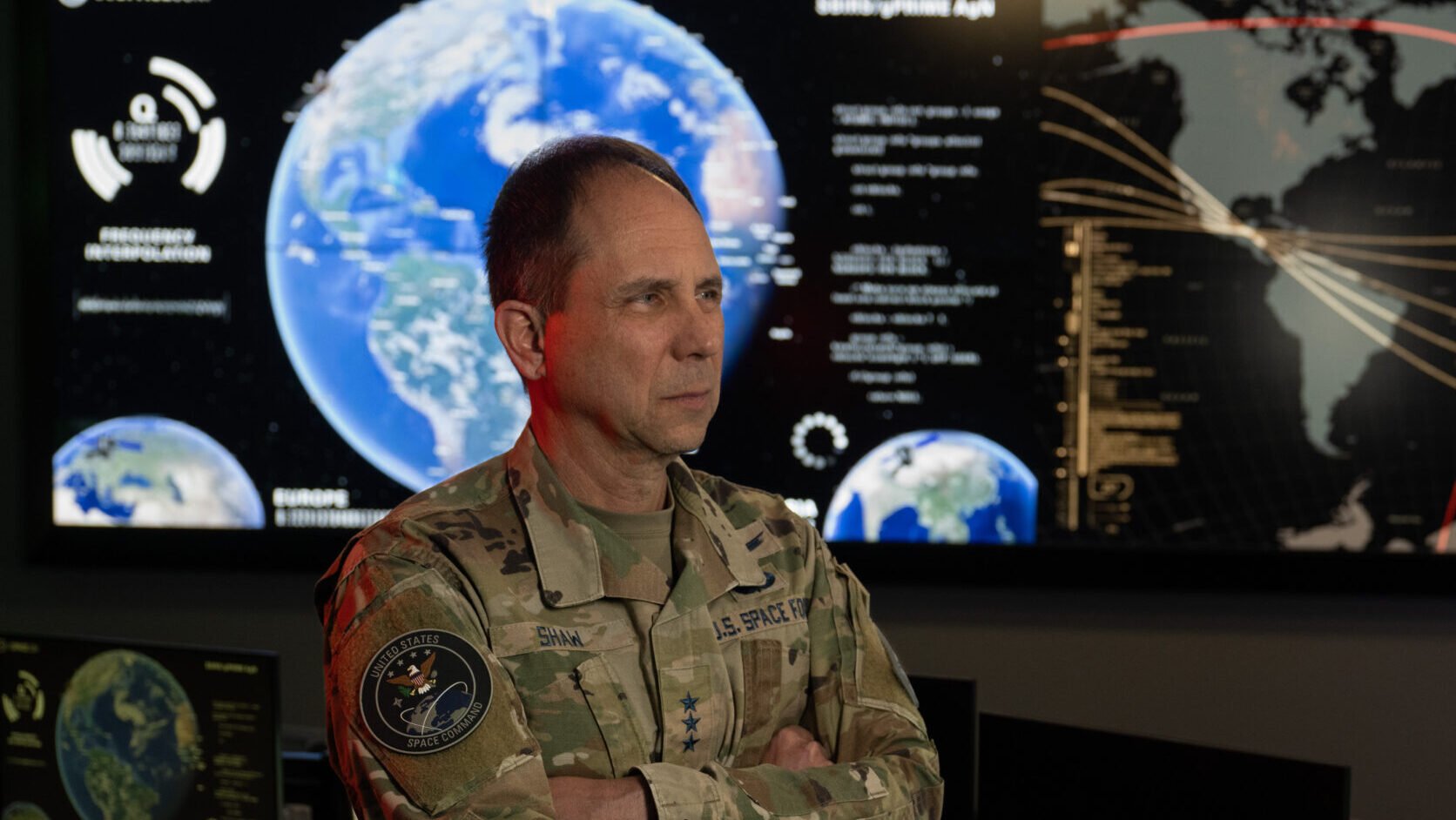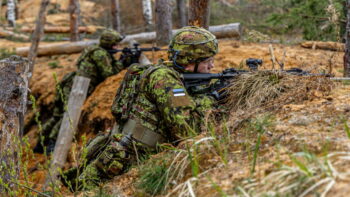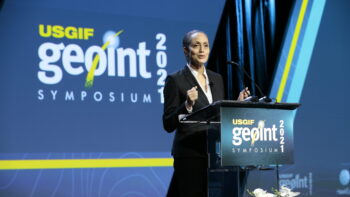
Lt Gen John Shaw, USSPACECOM Deputy Commander and Joint Operations Center personnel pose for a photo at USSPACECOM headquarters, Peterson Space Force Base, Colo. (John Ayre / United States Space Command)
ORLANDO — Lt. Gen. John Shaw retired as deputy head of US Space Command in October after serving 33 years, first in the Air Force and then in the Space Force. As an astronautical engineer, Shaw is one of an elite group of senior officers to have spent their entire career in space operations.
During his three-year stint at SPACECOM, Shaw was known for his far-sighted thinking about the role of space in how the US military will fight in the future. Perhaps his biggest claim to fame is as the father of the “dynamic space operations (DSO)” concept to conduct space-to-space-focused missions across the continuum from peacetime competition with China and Russia to crisis to war.
In his first media interview since retiring, Shaw spoke with Breaking Defense about DSO, the technical capabilities that will underpin it, and what it implies for the space domain. The conversation has been condensed and edited for clarity and brevity.
BREAKING DEFENSE: Over the past year or so, Pentagon officials have thrown around a number of different terms for future in-space capabilities, such as “space mobility,” “space logistics,” and “on-orbit servicing.” The latest term of art in this vein is “dynamic space operations.” Can you unpack that, what does it encompass and why is it important?
JOHN SHAW: First of all, I would distinguish it from space mobility, space logistics and on-orbit servicing, in that those are all kind of “means to ends.” Dynamic space operations is a combat mindset for space-on-space operations.
There are two traps to avoid in this discussion: that [DSO is aimed at] overall efficiency of operations and/or life extension. No. It’s about about enhanced maneuver capability from day one. … I want it so that I can maneuver freely on day one, or day 20.
I call what we’ve been doing today “positional space operations,” because we put satellites into orbits … then we tend to leave them in these orbits with very little energy change over their lifetime. The concept here is, for certain platforms and mission sets especially, more and more in the future positional is not going to cut it. We’re going to want them to be able to maneuver … freely maneuver and not be constrained by fixed fuel tanks and fixed, long-term lifetimes. So, I think it’s just a new way of looking at how we’re going to do a subset of overall space operations in the future for certain platforms.
We can’t do positional space operations exclusively forever. We’re going to have to be able to find ways to change the delta V equations and sustain maneuver, especially … in the face of an adversary who is doing the same things. … In a sense, we drive our satellites today as if we’re going to church. Our adversaries drive their satellites as if they’re going to combat.
What are SPACECOM’s priorities for these capabilities, and in what timeframe are they required?
I would say for some specific capabilities [and platforms], Space Command’s priority is for those to be able to sustain maneuver to conduct dynamic space operations. The unclassified example is GSSAP [Geosynchronous Space Situational Awareness Program satellites]. … It will be for those types of capabilities, not for all. Some things will remain positional, such as SATCOM [satellite communications] and GPS, almost any Earth-facing mission.
And what timeframe? When I left Space Command, we were driving towards 2028 to have a sustained maneuver capability on orbit for certain platforms. I think they’re still driving towards the end of the decade. … The technology level readiness levels, at least for refueling in orbit, are high.
What do you see as the greatest challenges to attaining these kinds of capabilities at the scope and timing needed?
In the near term it is clearly budget. Additional investment in spatial logistic layers and the infrastructure to support sustained maneuver in space does not come without additional cost. However, this cannot be an excuse to not pursue these capabilities. … It will be what the nation needs to sustain security in the domain. Other challenges are just going to be mindset changes. We have all grown up doing positional space operations and are in many ways just constrained by that thinking.
Do you expect to see new programs of record for developing related capabilities? Right now, the Space Force seems primarily focused on piggybacking on the commercial sector.
Right now, most of the work that’s being done is mainly R&D or demos. And that makes sense. But, yes, there will ultimately be programs of record, or standards for certain platforms to be able to be refuel-able or serviceable, and for refuelers. It’s just a matter of time before that happens and what path we take to get there. I think it’s possible that in the near term, you may have a purely commercial solution for refuelers. But further down the road, I think you’ll have a hybrid architecture.
Will the development of these sorts of capabilities require fundamental shifts in space operations thinking and execution, and if so how?
I would start to answer this by saying it really gives more tools to the combatant commanders, the secretary of defense and the president. Because now, since I can sustain maneuver, I can start maneuvering my satellites if a crisis develops and make an adversary wonder [what] I’m up to, and it might even deter them. So there’s a deterrent value here.
In the actual conduct of operations, absolutely. … There are some satellites, potential targets, we would like to go look at with GSSAP that we have to immediately say, ‘We can’t, because they’re just too high an inclination and it would just be too cost imposing.’ … So, I would just say it would widen our concepts of possibility in terms of space and time, where we can go and how quickly we can get there. And when you combine those things, now I can surprise an adversary. I can maintain initiative in ways I haven’t really thought about when I was doing purely positional operations.
The timelines [for maneuvering] are going to be vastly different than today. … it would really compress the timelines. … It’s not instantaneous, … but timelines for maneuvers, particularly for going and conducting operations in close proximity with other platforms, shrink from might be normally measured in weeks down to hours. … I wouldn’t want to oversell it, but I wouldn’t undersell it either. I mean, we could really make things challenging for an adversary.
Are the Space Force’s command, control and battle management systems up to speed enough to support DSO?
I already have requirements for space C2 to be able to do things in near-real time that it cannot do today. It needs to get there. … [U]nderstanding an adversary maneuvering, or space domain awareness, and tracking capabilities need to be near real time. I would say if we can achieve the requirements we have today for space C2 it will be pretty little added challenge how to incorporate DSO. What we have today isn’t sufficient for what we’re even doing today.
What are the greatest risks to not moving out quickly enough on DSO?
It’s inevitable that as we progress with space security operations in the future, both in the Earth-Moon system and beyond, that sustaining maneuver, is going to be the norm. It’ll be normal. And so, do we want to get there first, or last?






















